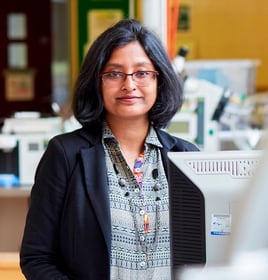
In the second interview in our series with our board members, we speak to Professor Anwesha Sarkar , Associate Professor of Food Colloids, School of Food Science and Nutrition at the University of Leeds, and FSTA Faculty Advisory Board member.
Tell us a little bit about what you do. What does an average working week look like for you?
I’m a Professor of Colloids and Surfaces at the University of Leeds, in the School of Food Science and Nutrition, and I’m the Director of Research and Innovation for our school.
In the first role, which is academic, I have three sets of work. One is teaching, where I teach undergraduate and master’s levels courses in colloid science. The second is research, and I supervise a research team of 14 PhD students, 3 Postdocs, 4 visiting researchers and numerous undergraduate and masters level researchers. I have regular meetings and brainstorming sessions with them to discuss ideas, to see how we can solve problems exploiting tools and techniques let’s say from other disciplines, ultimately to do cutting-edge research in oral processing to progress science. The third part is academic leadership, which is about building new collaborations, thinking about new directions in the colloid science space, arranging relevant conferences and scientific meetings, public engagement events and pushing the research agenda in general.
As the Director of Research and Innovation, my role is to identify research competency synergies within our School, with other departments, with other Universities, bring individuals and teams together, and try helping academic colleagues to bring the best out of them: to help hem write their grants, help developing their ideas fitting to relevant grant calls, and to help them have an independent, funded research career. There is a broader remit to see how I can support the school for developing the research strategy and vision, but individually, I chat with the academics and early career researchers, try to find academic mentors to help bringing their main research idea into life.
What do you enjoy most about your role?
The most fun part is to work every day with the early career researchers with curious minds and also I have a highly diverse team in terms of culture, country, gender, disciplinary strengths, stage of career etc. which makes it really enjoyable – they always have amazing ideas and those conversations are what I look for everyday. For me, the main thing is about pushing the boundaries of science. We are always solving problems. Sometimes the problems are everyday issues that we can think about in food, it can be a longstanding problem. Sometimes even a small sort of problem solving can give rise to a very interesting idea.

University of Leeds, United Kingdom
As a Member of FSTA’s Advisory Board, can you tell us why accepting this role appealed to you?
I have used FSTA since I was doing my master's in India. I used FSTA to do my literature review, so I thought it would be interesting to be on the other side of the table, to understand how I can help bring the best possible resource to the students.
Being a PI (Principal Investigator), I always mentor my students to do a really thorough literature review because for me, that's the most important step before you even start your research -without a thorough literature review, it is not possible to identify the right research questions. So, it was win-win to understand it from the inside out rather than the opposite way round. It was an interesting opportunity to see what goes on.
When I was a student, my university recommended FSTA, and I used it to look for abstracts, which was very useful. In many databases we have the full text, which sometimes actually makes things more confusing at the initial stage. FSTA abstracts are very useful because you just read the abstract and decide whether it’s in or out of scope, which is exciting.
Now, we use a lot of databases, and FSTA is definitely one of them. FSTA is a good starting point before you branch out, because it has a lot of access to the key papers, which is very useful.
What is something that excites you about the future of food research?
 We are at a very interesting intersection of sustainability and health. We need to think about things that are not only healthy for you, but also healthy for the planet, which is interesting and challenging to address.
We are at a very interesting intersection of sustainability and health. We need to think about things that are not only healthy for you, but also healthy for the planet, which is interesting and challenging to address.
For example, as colloid scientists, people have refrained from working with complicated systems like plant proteins and alternative proteins that are often ill-defined in terms of structure, sparingly soluble, have very high surface hydrophobicity, and so on. It's an exciting time to look at those tasks, which are challenging to work on and see what we can do with these systems that are much less characterised and functionally known to see if food colloid science can be helpful here.
What is the biggest challenge that food and nutrition science research faces?
From a global perspective, I think that funding is one of the biggest challenges when researching. When we look at funding opportunities, Health Science rightly receives significant funding, but the contribution of food to this entire health space is often underestimated. Most funding agencies are split into either Physical Sciences or Biological Sciences, whereas Food Science is very interdisciplinary from the outset, you need both physics and biological sciences to answer the most difficult questions . It becomes more difficult to gain funding, which is one of the stumbling blocks. Otherwise, there could have been many exciting pieces of research in this space.
Another element is that you can do a lot of research with well-defined polymers, but with food polymers, at the end of the day, you have to eat it. There is a sensory perspective, so it's much more complicated. It's a multi-step process to think about Food Science. It starts with Biology, moves to something very focused on Engineering, Chemistry, and Physics, and then moves back to something biological when you ingest it. It makes Food Science a very interesting as well as complex combination and interdisciplinary area of research. However, this makes it difficult, and is why we need people from multiple disciplines working in this area.
Over time, this has improved dramatically, and over the years, more and more interdisciplinary science is coming through, bringing new areas of study. For example, we worked on developing a biomimetic tongue-like 3D surface working with researchers in Departments of Mechanical Engineering, Dentistry, Computer Science, to understand tribology and friction happening in the mouth to give mechanistic understanding behind astringency, creaminess, smoothness etc. We couldn't have even dreamt it 30 years before because 3D printing was not that advanced, also there has been much advancement in the Polymer Science and Informatics recently. There’s a lot of synergy, and a lot of collaborative work going on across the world, which is very positive.
What are your thoughts on recent AI developments, like ChatGPT?
I have never used it, so I don't know the remit of it, but what I have heard in the news and from colleagues and staff, for me, it's a tool. As long as we use the tool in the right way, it's useful. Previously, people used to compute regression coefficient by themselves. Now we use various computational tools to do that for us, which is much faster. As long as you understand what you're doing and use AI as a tool it's alright. But never get enslaved by and get too reliant on any tool.
You can also read our most recent blog on how AI is revolutionising research and how it could be a potential hinderance here.
Is there any research or product where you think "I wish I had done that" ?
Yes, I thought the application of lipid nanoparticles for mRNA delivery for Covid-19 vaccines was quite interesting. I wish I would have been a part of it, but I'm pleased that at least I'm in this era where we can see such a huge effect of colloid science to protect lives and see the true impact of science straight away.
What tip or recommendation would you give to anyone starting out on their food science career?
Whenever you are looking for research papers, first start with a question in mind. There are so many more papers now than when I used to do my own graduate or masters research, so it’s very difficult to mine the relevant papers. Instead, start with a very clear question at the outset.
My next tip is to go beyond Food Science and Nutrition papers. Go to a fundamental Physics, Chemistry, or go to Biology. Go beyond the realms and then try to understand what parallel work has been done on a system which is not the exact biopolymer you're looking at, but a polymer with a very similar structure, for example. This can give you a lot of fundamental principles and insights to understand what happens in a much more complex system, such as food.
You may also find our Literature search best practice guide helpful when carrying out searches.
Thinking creatively, if you could create any food or drink ingredient or product, what would it be?
I always like to think about whether we can create stable emulsion-based beverages that taste amazing in the mouth but also releases bioactive ingredients at relevant biological sites for health benefits; imagine omega 3-oil containing drinks which has no pungency or fishy odour when consuming but also releases the beneficial actives in the gut at a sustained rate for maximum adsorption – so a true controlled release kind of a food beverage.

Your recent research article on the texture of chocolate has gained a wide audience, including being featured in mainstream news and other media outlets worldwide. How was this experience?
I never anticipated it. It was an exciting piece of research and a very well-thought-out and well-designed experiment. However, we never imagined that we would get phone calls from so many press media outlets, so it was very reassuring. It was very welcome, as we should talk more about science to a general audience. People should learn what research goes on in universities; it’s not just for people studying there. A simple piece of chocolate has so much physics and chemistry in it when it melts in the mouth and mixes with saliva, which is sometimes not appreciated enough, so it's very encouraging.
If confident with their data and reproducibility, scientists should talk to general audience through different channels, whether through social media or elsewhere. It is important to talk about robust science backed up by evidence with people, as this is how we can progress. Even if we have a fantastic piece of research, if nobody reads it, then it's not a good use of the general public's investment. As long as the research is backed up by evidence, it’s beneficial and could reach someone who has a use for it, which they may not have otherwise thought about.
Finally, did any problems arise from having your research exposed to people who may usually have no interest in Food Science?
There were a lot of questions asking, “Where is this healthy chocolate?” and we said from the beginning that we have not made any chocolate. We’re understanding the fundamental science behind it; we’re also not trying to preach to people to eat chocolate. It is about understanding why so we can use that mechanistic knowledge to do something else, in some other applications.
Fortunately, we did not have any such kind of incidents. It has been very interesting talking to people from different countries and media environments about something like Food Science. To people’s surprise, Food Science is way more complicated than they think. Even when just looking at the process of consumption, which is just a few seconds, so many things across scale and time are going on in your mouth, which is why it’s so exciting to advance on this study.

